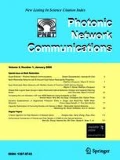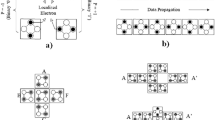Abstract
This article proposes the thermometer code converter, which eliminates the requirement of binary code converter to generate gray codes in different digital modulation techniques like pulse code modulation. The nanoscale faster low-power circuit for these thermometer code-to-gray code converter has been achieved with quantum-dot cellular automata (QCA). The proposed converter circuit is made up with new QCA 2:1 multiplexer, which dominates the other existing designs in terms of QCA cells and device density. The circuits are evaluated based on area and operating speed. The design consistency is verified through theoretical values. The dissipated energy explores that the designs have lower energy dissipation. Stuck-at-fault effect analysis on the circuits has been performed. Besides, defect analysis caused by single missing cells, single extra added cells and misplaced cells is also explored. Test vectors are proposed to achieve 100% defect coverage. As encoders, these circuits can be widely employed in those high-performance functions that impose extraordinary design constraints with respect to high frequency, minimal area and low energy consumption.






Similar content being viewed by others
References
Lent, C.S., Tougaw, P.D.: A device architecture for computing with quantum dots. Proc. IEEE 85(4), 541–557 (1997)
Lent, C.S., Tougaw, P.D., Porod, W., Bernstein, G.H.: Quantum cellular automata. Nanotechnology 4(1), 49–57 (1993)
Lent, C.S.: Bypassing the transistor paradigm. Science 288, 1597–1599 (2000)
Tougaw, P.D., Lent, C.S.: Logical devices implemented using quantum cellular automata. J. Appl. Phys. 75, 1818–1825 (1994)
Pudi, V., Sridharan, K.: A bit-serial pipelined architecture for high-performance DHT computation in quantum-dot cellular automata. IEEE Trans. Very Large Scale Integr. (VLSI) Syst. 23, 2352–2356 (2015)
Das, J.C., De Debashis, S.P., Mondal, A Ahmadian, Ghaemi, F., Senu, N.: QCA based error detection circuit for nano communication network. IEEE Access 7, 67355–67366 (2019)
Angizi, S., Moaiyeri, M.H., Farrokhi, S., Navi, K., Bagherzadeh, N.: Designing quantum-dot cellular automata counters with energy consumption analysis. Microprocess. Microsyst. 39, 512–520 (2015)
Fam, S.R., Navimipour, N.J.: Design of a loop-based random access memory based on the nanoscale quantum dot cellular automata. Photon Netw. Commun. 37(1), 120–130 (2019)
Debnath, B., Das, J.C., De, D.: Correlation and convolution for binary image filter using QCA.". Nanomater. Energy 5(1), 61–70 (2016)
Norouzi, A., Heikalabad, S.R.: Design of reversible parity generator and checker for the implementation of nano-communication systems in quantum-dot cellular automata. Photon. Netw. Commun. 38(2), 231–243 (2019)
Thapliyal, H., Ranganathan, N., Kotiyal, S.: Design of testable reversible sequential circuit. IEEE Trans. Very Large Scale Integr. (VLSI) Syst. 21, 1201–1209 (2013)
Maroufi, N., Bahrepour, D.: A novel three-input approximate XOR gate design based on quantum-dot cellular automata. J. Comput. Electron. 17(2), 866–879 (2018)
Wang, L., Xie, G.: Novel designs of full adder in quantum-dot cellular automata technology. J Supercomput (2018). https://doi.org/10.1007/s11227-018-2481-8
Rao, N.G., Srikanth, P.C., Sharan, P.: A novel quantum dot cellular automata for 4-bit code converters. Optik-Int. J. Light Electron Opt. 127, 4246–4249 (2016)
Misra, N. K., Wairya, S., Singh, V. K.: Optimized approach for reversible code converters using quantum dot cellular automata. In Proceedings of the 4th international conference on frontiers in intelligent computing: theory and applications (FICTA) (pp. 367–378). Springer, India (2015)
You, Y.W., Jeon, J.C.: Design of extendable BCD-EXCESS 3 code convertor using quantum-dot cellular automata. J. Adv. Navig. Technol. 20, 65–71 (2016)
Karkaj, E.T., Heikalabad, S.R.: Binary to gray and gray to binary converter in quantum-dot cellular automata. Optik-Int. J. Light Electron Opt 130, 981–989 (2017)
Ahmad, F., Bhat, G.M.D., Zahoor, P., Farooq, R.: Design of N-bit code converter using quantum-dot cellular automata (QCA).". Adv. Sci. Eng. Med. 7, 370–377 (2015)
Gladshtein, M.: Quantum-dot cellular automata serial decimal processing-in-wire: run-time reconfigurable wiring approach. Microelectron. J. 55, 152–161 (2016)
Ramesh, B., Rani, M.A.: Design of binary to BCD code converter using area optimized quantum dot cellular automata full adder. Int. J.Eng. (IJE). 9, 49–64 (2015)
Das J. C., De, D.: quantum dot cellular automata based cipher text design for nano communication. In: International conference on radar, communication and computing (ICRCC), SKP Engg. College, Tamilnadu, India, 2012, pp. 343–348. https://doi.org/10.1109/ICRCC.2012.6450583.
Das, J.C., Debnath, B., De, D.: Reversible gate based cipher text using QCA for nanocommunication. Nanomater. Energy 6, 7–16 (2017)
Sardinha, L.H., Costa, A.M.M., Neto, O.P.V., Vieira, L.F.M., Vieira, M.A.M.: Nanorouter: a quantum-dot cellular automata design. IEEE J. Sel. Areas Commun. 31, 825–834 (2013)
Das S., De D.: Nanocommunication using QCA: a data path selector cum router for efficient channel utilization, In Proc. ICRCC, SKP Engg. College, Tamilnadu, India, 2012, pp. 43–47
Yao, F., Zein-Sabatto, M.S., Shao, G., Bodruzzaman, M., Malkani, M.: Nanosensor data processor in quantum-dot cellular automata. J. Nanotechnol. (2014). https://doi.org/10.1155/2014/259869
Kamaraj, A., Ramya, S.:Design of router using reversible logic in quantum cellular automata. In International Conference on communication and network technologies (ICCNT), 2014. https://doi.org/10.1109/CNT.2014.7062764
Das, J.C., Purkayastha, T., De, D.: Reversible nano-router using QCA for nanocommunication. Nanomater. Energy 5, 28–42 (2016)
Silva, D., Sardinha, L., Vieira, M., Vieira, L., Neto, O.V.: Robust serial nano-communication with QCA. IEEE Trans. on Nanotechnol. 13, 464–472 (2015)
Das, J.C., De, D.: Quantum Dot-Cellular Automata Based Reversible Low Power Parity Generator and Parity Checker Design for Nanocommunication. Front. Inf. Technol. Electron. Eng. 17, 224–236 (2016)
Das, J.C., Debnath, B., De, D.: Image Steganography using Quantum dot Cellular Automata. Quantum Matter. 4, 504–517 (2015)
Debnath, B., Das, J.C., De, D.: Reversible logic based image steganography using QCA for secure nanocommunication. IET Circuits Devices Syst. 11, 58–67 (2017)
Brown, S., Vranesic, Z.: Fundamental of Digital Logic Design with VHDL, TATA McGraw Hill companies, 2007.
Gupta, Y., Garg, L., Khandelwal, S., Gupta, S., Saini, S.: Design of low power and high speed multiplexer based thermometer to gray encoder. In Proceedings of intelligent signal processing and communications systems (ISPACS), Naha, Japan, (2013). https://doi.org/10.1109/ISPACS.2013.6704602
Gupta, Y., Saini, S.: Thermometer to Gray Encoders, Advances in Computer and Electrical Engineering. pp. 323–335, 2015. https://doi.org/10.4018/978-1-4666-6627-6.ch013
Khosroshahy, M.B., Moaiyeri, M.H., Navi, K., Bagherzadeh, N.: An energy and cost efficient majority-based RAM cell in quantum-dot cellular automata. Results Phys. 7, 3543–3551 (2017)
Liu, W., Lu, L., O’Neill, M., Swartzlander, E.E.: A first step toward cost functions for quantum-dot cellular automata designs. IEEE Trans. Nanotechnol. 13(3), 476–487 (2014)
Ramesh, B., Rani, M.A.: Design of an optimal decimal adder in quantum dot cellular automata. Int. J. Nanotechnol Appl 11(2), 197–211 (2017)
Das, J.C., De, D.: Optimized multiplexer design and simulation using quantum dot-cellular automata. Indian J. Pure Appl. Phys. 54, 802–811 (2016)
Rashidi, H., Rezai, A.: Design of novel efficient multiplexer architecture for quantum-dot cellular automata. J. Nano- Electron. Phys. 9, 01012 (2017)
Sen, B., Dutta, M., Goswami, M., Sikdar, B.K.: Modular design of testable reversible ALU by QCA multiplexer with increase in programmability. Micro. J. 45, 1522–1532 (2014)
Sen, B., Nag, A., De, A., Sikdar, B.K.: Towards the hierarchical design of multilayer QCA logic circuit. J. Comput. Sci. 11, 233–244 (2015)
Mukhopadhyay, D., Dutta, P.: quantum cellular automata based novel unit 2:1 multiplexer. Int. J. Comput. Appl. 43, 22–25 (2012)
Beigh, M. R., Mustafa, M.: Performance evaluation of multiplexer designs in quantum-dot cellular automata (QCA). In International conference on advances in computers, communication and electronic engineering, University of Kashmir, India, March 16–18, (2015). pp. 245–249
Sabbaghi-Nadooshan, R., Kianpour, M.: A novel QCA implementation of MUX-based universal shift register. J. Comput. Electr. 13, 198–210 (2013)
Roohi, A., Khademolhosseini, H., Sayedsalehi, S., Navi, K.: A novel architecture for quantum-dot cellular automata multiplexer. Int. J. Comput. Sci. Issues. 8, 55–60 (2011)
Chabi, A.M., Roohi, A., Khademolhosseini, H., Sheikhfaal, S., Angizi, S., Navi, K., DeMara, R.F.: Towards ultra-efficient QCA reversible circuits. Microprocess. Microsyst. 49, 127–138 (2017)
Rashidi, H., Rezai, A.: Design of novel efficient multiplexer architecture for quantum-dot cellular automata. J. Nano Electron. Phys. 9(1), 01012 (2017)
Khan, A., Mandal, S.: Robust multiplexer design and analysis using quantum dot cellular automata. Int. J. Theor. Phys. 58(3), 719–733 (2019)
Khosroshahy, M.B., Moaiyeri, M.H., Angizi, S., Bagherzadeh, N., Navi, K.: Quantum-dot cellular automata circuits with reduced external fixed inputs. Microprocess. Microsyst. 50, 154–163 (2017)
Liu, W., Srivastava, S., Lu, L., O’Neill, M., Swartzlander, E.E.: Are QCA cryptographic circuits resistant to power analysis attack? IEEE Trans. Nanotechnol. 11, 1239–1251 (2012)
Xiaojun, M., Huang, J., Metra, C., Lombardi, F.: Detecting multiple faults in one-dimensional arrays of reversible QCA gates. J. Electron. Test. 25, 39–54 (2009)
Sen, B., Dutta, M., Sikdar, B.K.: Efficient design of parity preserving logic in quantum-dot cellular automata targeting enhanced scalability in testing. Microelectronics J. 45, 239–248 (2014)
Tahoori, M., Momenzadeh, M., Huang, J., Lombardi, F.: Testing of quantum cellular automata. IEEE Trans. Nanotechnol. 3, 432–442 (2004)
Tahoori, M. B., Momenzadeh, M., Huang, J., Lombardi, F.: Defects and faults in quantum cellular automata at nano scale, In Proc. of the 22nd IEEE VTS, pp. 291–296, (2004).
Momenzadeh, M., Ottavi, M., Lombardi, F.: Modeling QCA defects at molecular-level in combinational circuits, in Proc. of the 20th IEEE DFT, pp. 208–216 (2005).
Author information
Authors and Affiliations
Corresponding author
Additional information
Publisher's Note
Springer Nature remains neutral with regard to jurisdictional claims in published maps and institutional affiliations.
Rights and permissions
About this article
Cite this article
Das, J.C., De, D. Design of thermometer code-to-gray code converter circuit in quantum-dot cellular automata for nano-computing network. Photon Netw Commun 41, 259–273 (2021). https://doi.org/10.1007/s11107-021-00937-9
Received:
Accepted:
Published:
Issue Date:
DOI: https://doi.org/10.1007/s11107-021-00937-9




